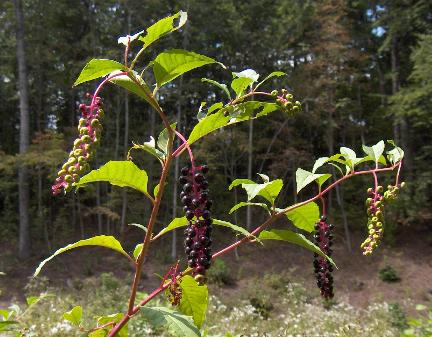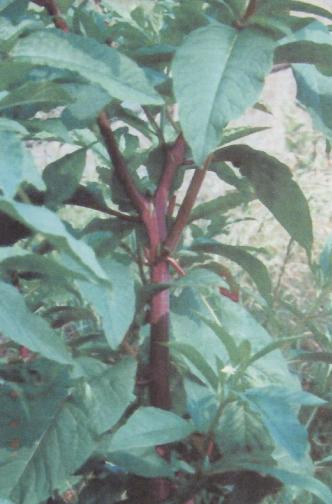
















Grandpappy's Basic Recipes
Poke Sallet Weed
Copyright © April 19, 2008 by Robert Wayne Atkins, P.E.
All Rights Reserved.
For Educational Purposes Only.
New Food Precaution
Since some people are allergic to common ordinary foods, such as milk products and eggs and nuts, it is only reasonable to suspect that some people will be allergic to some wild foods, such as poke sallet weed.
Never eat any wild food that you cannot positively identify.
Whenever you are experimenting with any new food you have never eaten before, you should only experiment with a very, very small quantity of it the first time you try it to determine if you are allergic to it. If you have an allergic reaction to any food then you should immediately consult a licensed medical professional.
Chew one teaspoon full of the properly prepared wild food and them immediately spit it all out. Wait 24 hours to see if you develop an allergic reaction to the food. If you do not experience a negative reaction then the next day you can chew and swallow one teaspoon full of the properly prepared wild food and then wait another 24 hours to see how your system responds.
If you have an allergic reaction to the food, then you should avoid it in the future.
However, if you do not develop any allergic reactions to a very small quantity of the food, then the next day you may eat a little more of it.
It is not wise to eat too much of an unknown food that your body has never digested before. Always begin with a very meager portion and then gradually add just a little more each day to help prevent a serious allergic reaction to a new food.
Introduction to Poke Sallet Weed
(Harvest in the Early Spring to Mid-Summer)
Do not confuse the word "sallet" for "salad." The traditional use of these two words has been as follows:
- Sallet o(r Salet) refers to cooked greens.
- Salad refers to uncooked greens.
In the past Allens brand canned foods sold cooked "Poke Salet Greens" in a 14.5 ounce can but they discontinued this product in April of the year 2000.
 Uncooked raw poke leaves are mildly poisonous and may cause vomiting and diarrhea, both of which can be easily avoided by boiling the leaves before eating them. Also, poke leaves should be picked in the spring or early summer when they are no more than 6 to 8 inches long. After mid-July, the veins in the leaves turn red and the leaves are too mature and contain toxin levels that can be unsafe.
Uncooked raw poke leaves are mildly poisonous and may cause vomiting and diarrhea, both of which can be easily avoided by boiling the leaves before eating them. Also, poke leaves should be picked in the spring or early summer when they are no more than 6 to 8 inches long. After mid-July, the veins in the leaves turn red and the leaves are too mature and contain toxin levels that can be unsafe.
By late summer, the plant can be between six to seven feet tall. The picture on the right is a mature poke weed. The plant in the picture is too mature to be used as food.
When the poke leaves on a poke plant begin to show red or purple veins then the poke plant can be broken off at the ground and discarded. If the weather is still warm then the roots in the ground will produce another poke plant that has fresh young new poke leaves.
Poke weed is recognized by its magenta or purple main stalk. The leaves are between 6" to 10" long and about 2" to 3" wide.
The summer flowers are small and white or pinkish and they are followed by green berries which turn dark purple when they ripen (see picture). Do not eat the flowers, berries, the main purple stalk that supports the branches, or the roots. The root is extremely poisonous.
Never eat the poke berries. However, the berries may be crushed and their juice used to make a red dye or a red ink. Inside each berry there are between 8 to 13 black seeds. The seeds are also poisonous and the seeds should never be eaten.
Young Poke Leaves
 During the Great Depression of the 1930s young poke sallet leaves were widely eaten by many southern families on a regular basis. In my opinion boiled young poke leaves have a consistency and taste similar to a mixture of boiled spinach, collard, and turnip greens.
During the Great Depression of the 1930s young poke sallet leaves were widely eaten by many southern families on a regular basis. In my opinion boiled young poke leaves have a consistency and taste similar to a mixture of boiled spinach, collard, and turnip greens.
In the early spring, poke sallet reaches a height of about one or two feet. When the entire plant is 12 inches tall (or shorter) and the new leaves are on top of the new shoots and the plant has not yet formed side branches, then the young tender shoots and leaves may be harvested and prepared following the cooking directions that appear below. However, after the plant has started to produce side branches with leaves (picture on right) then the main purple stalk contains poisons and it should not be eaten. However, the leaves shown in the picture on the right can be harvested and cooked following the directions that appear below.
Young poke leaves are rich in vitamins and minerals. Poke leaves contains protein, carbohydrates, calcium, phosphorus, iron, vitamin A, thiamine (B1), riboblavin (B2), niacin (B3), plus a lot of vitamin C. Poke leaves are very nutritious but before you eat them you must boil the leaves in clean fresh water to remove the toxins from the leaves.
Cooking:
Note: If you prefer very tender cooked greens then boil for the maximum times shown below. If you prefer less tenderness and more firmness then boil for the minimum times shown below.
First Boil: Rinse each leaf by itself under clean running water and then cover the leaves with fresh water in a cook pot. Bring the water to a boil and allow the water to boil for ten to fifteen minutes. Drain as much water as possible from the leaves using a colander or a strainer.
Second Boil: Add fresh clean water to the cook pot and bring the water to a boil and boil the leaves for two to five minutes. Drain as much water as possible from the leaves in a strainer.
Third Boil (Optional): Add fresh clean water to the cook pot. Boil the leaves a third time for one minute and then drain off the water.
Serve the tender pokes leaves the same way you would boiled spinach.
Warnings:
- Do not eat mature poke leaves that have visible red veins in the leaf itself. Only pick young poke sallet leaves.
- Do not eat poke leaves until after you have boiled them at least two times (or three times if you want to be really safe).
- Do not eat poke leaves if you are pregnant or nursing.
You should use the same degree of caution with poke sallet leaves as you would with raw pork meat. Raw pork should never be eaten until after it has been thoroughly cooked. After the pork has been cooked well done then it can be safely consumed. The same exact principle applies to raw poke sallet leaves. Never eat the leaves until after they have been boiled in clean water at least two times. After two (or three) boilings young poke sallet leaves may be safely consumed.
Footnote
If a food item is boiled to make it safe to eat, and that food does not contain any harmful substances, then a single boiling for the appropriate amount of time is usually adequate to make the food edible and digestible.
However, if a food item contains substances that are harmful to the human body, and the purpose of the boiling is to remove the danger of those harmful substances, then for safety and health reasons the food is normally boiled more than one time, and the water is changed between each boiling. The reason is because the water from the first boiling will contain most of the harmful substances. If the food item is simply removed from that water and consumed, then some of the harmful substances may still be on the food because the food was in contact with the water and the harmful substances just prior to eating.
If the first water is discarded and fresh water is added to the cook pot, and the food is boiled again, then the fresh water has a chance to extract any remaining harmful substances that may still be clinging to the food item. For safety and health reasons, some food items are boiled in fresh water a third time. After the third boil the chance of any harmful substances still being on the food is significantly reduced.
Grandpappy's e-mail address is: RobertWayneAtkins@hotmail.com




































 Uncooked raw poke leaves are mildly poisonous and may cause vomiting and diarrhea, both of which can be easily avoided by boiling the leaves before eating them. Also, poke leaves should be picked in the spring or early summer when they are no more than 6 to 8 inches long. After mid-July, the veins in the leaves turn red and the leaves are too mature and contain toxin levels that can be unsafe.
Uncooked raw poke leaves are mildly poisonous and may cause vomiting and diarrhea, both of which can be easily avoided by boiling the leaves before eating them. Also, poke leaves should be picked in the spring or early summer when they are no more than 6 to 8 inches long. After mid-July, the veins in the leaves turn red and the leaves are too mature and contain toxin levels that can be unsafe. During the Great Depression of the 1930s young poke sallet leaves were widely eaten by many southern families on a regular basis. In my opinion boiled young poke leaves have a consistency and taste similar to a mixture of boiled spinach, collard, and turnip greens.
During the Great Depression of the 1930s young poke sallet leaves were widely eaten by many southern families on a regular basis. In my opinion boiled young poke leaves have a consistency and taste similar to a mixture of boiled spinach, collard, and turnip greens.
